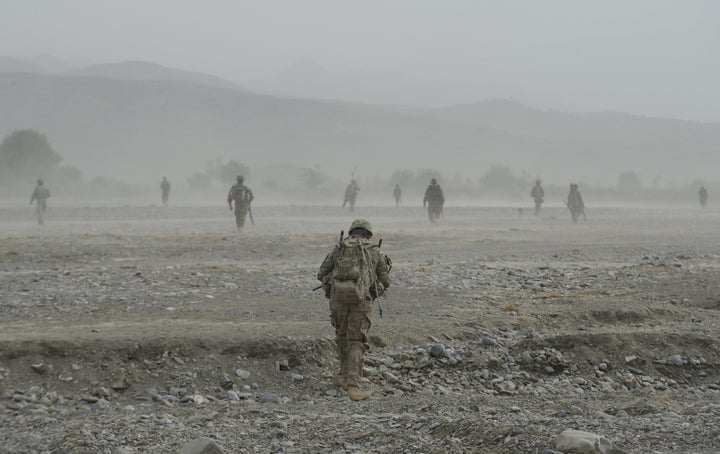
WASHINGTON -- President Barack Obama's decision to withdraw troops from Afghanistan signals the beginning of the end for the ambitious counterinsurgency strategy that Army Gen. David Petraeus designed and has single-mindedly pursued in Iraq and Afghanistan.
His strategy, which embraced the concept of "winning the people'' rather than simply killing the enemy, has attracted a growing number of critics -- including Vice President Joe Biden, senior members of Congress and even veteran military officers -- who contend that it didn't work in Iraq and hasn't worked in Afghanistan. Within the ranks, COIN has become known disparagingly as "armed nation building."
The very real gains in Afghanistan, military critics say, have come because of hard and innovative fighting by American troops, not because of nation building -- armed or otherwise.
Now, the president has declared that the short-term "surge" of 30,000 troops he authorized 18 months ago has worked in achieving limited goals, and it's time to move on. Using counterinsurgency warfare as a means to such lofty goals as creating a constitutional democracy and a vibrant market economy in Afghanistan, even promoting women's rights, are largely gone.
Even the Army is distancing itself from the COIN doctrine it has embraced for a decade. Its new strategy refocuses the Army's warfighting brigades on traditional combat formations. COIN is conspicuously absent from the revised concept, which was developed under the direction of Army Gen. Martin Dempsey, Obama's nominee to be the new chairman of the Joint Chiefs of Staff. The president removed Petraeus from military command and nominated him to head the Central Intelligence Agency.
"Army forces capable of combined arms maneuver and wide area security operations are an essential component of the joint force’s ability to achieve or facilitate the achievement of strategic and policy goals," Dempsey wrote in an introduction to the new strategy.
That's a far cry from the guidance Petraeus issued to all U.S. and allied troops when he took command in Afghanistan last summer.
"Secure and serve the population," he instructed. "Live among the people." Work against "inadequate governance, corruption and abuse of power." With 100,000 U.S. military personnel assigned to Afghanistan to carry out these orders, the cost of the war soared to over $8 billion a month.
Backing up that COIN campaign has been a massive aid effort that so far has poured $19 billion into Afghanistan. Much of it has disappeared, according to the bipartisan Congressional Commission on Wartime Contracting. Or it has simply proven ineffective, the Senate Foreign Relations Committee concluded recently after a two-year study.
What made the Petraeus COIN doctrine so difficult, according to combat commanders on the ground in Afghanistan, was the massive loss of "human capital'' as educated Afghans fled the wars of the 1980s and 1990s, leaving the country largely one of illiterate small-plot farmers. Major corruption, which grew out of the opium trade, was further fueled by billions of dollars of U.S. aid.
Education and democratic government were held out as cures for these ills. While millions of children now throng the nation's schools, declining participation in elections has dimmed hopes for popular representative government.
"Based on the past ten years, population protection and nation building as U.S. military missions have failed," declared Bing West, a Marine combat veteran and best-selling author, in his latest book, "The Wrong War." There were too few U.S. and allied troops to actually protect the Afghans in their thousands of small villages, he argued. And most nation building involved U.S.-financed projects bestowed as gifts on Afghans who "became accustomed to receiving something for nothing, and giving nothing in return," West observed after returning from several extended reporting trips in Afghanistan.
Ironically, the U.S. COIN campaign has an eerie parallel to the strategy pursued by the Soviet Union's Red Army. The Soviet's inglorious 10-year defeat in Afghanistan cost some 15,000 lives.
Like the Red Army, U.S. forces under Petraeus are seeking to protect the Afghan population, who mostly live in Afghanistan's cities and large towns. "This is not where the Taliban primarily operate, and when they do, they are extremely difficult to identify or separate from the population,'' write Larry Goodson of the U.S. Army War College and Thomas H. Johnson of the Naval Postgraduate School in Monterey, Calif.
"It is virtually impossible to defeat a rural insurgency in a largely agrarian country by securing the urban areas," they write in an essay published in Small Wars Journal. "The Soviets eventually learned this; apparently the United States has yet to do so.'' In its present form, they add, "current U.S. Afghan strategy holds little promise for success.'''
Other faulty assumptions lie behind the failure of the population-centric COIN doctrine laid out by Petraeus in both Afghanistan and Iraq, said retired Marine Col. T.X. Hammes, senior research fellow at the Institute for National Strategic Studies at the National Defense University in Washington.
The strategy assumed "that President Karzai could create a viable stable and legitimate government -- a pretty iffy assumption, and that somebody would close the insurgent sanctuaries in Pakistan. We tried and the Pakistanis tried, and neither succeeded. And there was a mismatch between ends and means," Hammes told The Huffington Post. There were too few troops to achieve the "maximalist" goal of creating a stable, effective, national government, he said.
"American armed nation building at the barrel of a gun simply does not work,'' concludes Army Col. Gian P. Gentile, a two-tour combat veteran of Iraq who holds a doctorate degree in history from Stanford University. There are alternatives to counterinsurgency, he told HuffPost in an interview earlier this year. "But they are hard to articulate with Army and senior leaders who've been doing this for nine years and are morally committed to it because we've shed blood, and they believe they can make it work."
That conclusion has been reached on Capitol Hill as well, as Sen. Robert Menendez (D-N.J.), an early and longtime supporter of the war in Afghanistan, observed in a floor speech Monday: "In my mind not only are the costs and lives and treasure far too high, but there is a growing consensus that, absent a very long and sustained commitment involving many troops on the ground, we can't win the hearts and minds of the Afghan people -- or, for that matter, even President Karzai."
If not counterinsurgency, what will work in Afghanistan?
Smaller forces, more modest goals, according to retired Army Gen. David Barno, among others. He was the top U.S. and allied combat commander in Afghanistan from 2003 to 2005, and favors a decisive shift away from the current large-scale counterinsurgency campaign and turning over to Afghan forces the job of fighting the Taliban. American and allied forces can be cut to 25,000 to 35,000, he said, from the current level of 100,000 American soldiers and 40,000 allied troops. The remaining Americans would help train the Afghan security forces and hunt down any remaining al Qaeda operatives.
Assertions that American counterinsurgency could secure Afghanistan and improve life for most Afghans were "grossly inflated'' at the outset of the war, Barno told The Huffington Post. And in the nine years that have followed, the reality of what the United States has delivered in terms of nation building "has fallen short."
